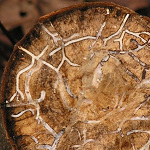 |
The Global Invasive Species Team |  |
|
Gallery of Pests:
Pests & pathogens not too widely spread Laurel wilt & ambrosia beetle - Ophiostoma sp. & Xyleborus glabratus Eichhoff - Faith Campbell - - March 2006 - Photographs Click on the images below to view photographs. Complete photographic credits are given here.
An ambrosia beetle and associated fungus in the Ophiostoma genus
Mortality of redbay trees (Persea borbonia) has been reported in coastal areas of Georgia and South Carolina (J. Johnson, Georgia Forestry Commission, pers. comm. 4/2005) since 2003; in 2005 the problem was also found in northeast Florida (J. Foltz, University of Florida, pers. comm. 11/2005). The apparent cause of mortality is a previously unknown fungus in the genus Ophiostoma (the same genus as the "Dutch" elm disease which has killed many elms in North America). The fungus is apparently transported (vectored) by a recently introduced ambrosia beetle from Asia, Xyleborus glabratus, and possibly other beetles (S. Fraedrich, USDA Forest Service Southern Research Station, pers. comm. 11/2005). The beetle was first detected in the United States in 2002 near Port Wentworth, Georgia. It is possible that the infestation in northeast Florida is a separate introduction, since no infestation has yet been found on several of the barrier islands between the Georgia and Florida infestations (i.e., St. Simons, Jekyll, and Cumberland islands in south Georgia and Amelia Island in north Florida and others, although not all have been surveyed) (R. Bryant, National Park Service, pers. comm. 11/2005). Redbay is important to wildlife (Brendemuehl, 1990). The fruit is eaten by wild turkey, bobwhite quail and several species of song birds. Deer also consume the fruits and leaves (Brendemuehl, 1990). An additional ecological concern is the dependence of the Palamedes swallowtail butterfly (Papilio palamedes) on redbay and swamp bay (Persea palustris) as larval hosts (J. Foltz, University of Florida, pers. comm. 11/2005). A second butterfly, the spicebush swallowtail (Papilio troilus), is also dependant on species in the family Lauraceae and might be harmed if the pathogen proves to damage additional woody plants in that family (J. Foltz, University of Florida, pers. comm. 11/2005). Park managers and municipalities already face rising costs for removal of dead and dying trees that pose a hazard to the public (R. Bryant, National Park Service, pers. comm. 11/2005). Disposal of the trees presents its own challenges, since moving the wood could spread the disease whereas leaving significant amounts of woody debris on site could be a fire hazard (Fraedrich pers. comm. 11/05). In the field, X. glabratus has been observed attacking only redbay and sassafras (Sassafras albidum). Sassafras trees colonized by X. glabratus and the Ophiostoma fungus have been killed at two locations in Liberty County, Georgia. Other potential hosts in North America are unknown at this time but may include other plants in the Lauraceae (Table 1). Stephen Fraedrich of the USDA Forest Service is testing additional species in the Lauraceae family for vulnerability to the disease. To date, spicebush (Lindera benzoin) and swamp bay have become infected and died in growth chamber studies. One member of the family is a federally listed endangered species: pond berry (Lindera melissafolium). Georgia and South Carolina intend to conduct a formal survey for the disease in 2006 if funding is made available by the USDA Forest Service (J. Johnson, Georgia Forestry Commission pers. comm. 11/2005).
A compelling article about laurel wilt, as it is killing red bay (Persea borbonia), was written by Susan Cerulean, and has been posted on line at http://terrain.org/articles/22/cerulean.htm. Sources Brendemuehl, R. H. 1990. Persea borbonia (L.) Spreng. Redbay. Pg. 503-506 in Silvics of North America. Volume 2. Hardwoods. USDA Forest Service. Agriculture Handbook 654.Washington, DC.
|
||||||||||||||||||||||||||||||||||||||||||||||||
Updated July 2008 ©The Nature Conservancy, 2004 |
|||||||||||||||||||||||||||||||||||||||||||||||||





